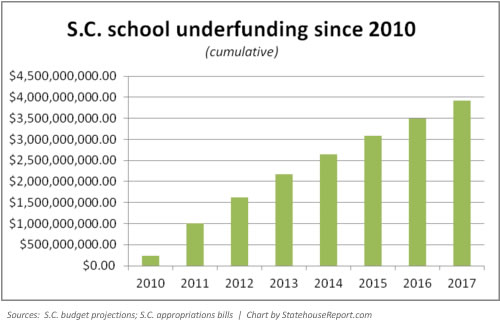By Lindsay Street, Statehouse correspondent | Education advocates in the state are cheerleading the Senate’s draft budget for its focus on K-12 education, but they say work still needs to be done to restore the main stream of funding for public schools in South Carolina.
State law requires per-student funding for public schools to be $2,959 per year in the 2018-19 budget. But proposed funding for the coming year remains hundreds of millions below required levels.
In the current 2017-18 fiscal year, the state spent $2,425 per student to fund public education, an increase of $75 per student over the previous year’s $2,350 base student cost.
 For next year’s budget, Gov. Henry McMaster sought a $10 increase to the base student cost. House budget writers sought to keep it the same from the previous year. Now, the Senate budget writers are drafting a $60 increase to $2,485. The Department of Education requested a $125 per student increase, but even that wouldn’t bring the base-student cost up to the state-required level of $2,959.
For next year’s budget, Gov. Henry McMaster sought a $10 increase to the base student cost. House budget writers sought to keep it the same from the previous year. Now, the Senate budget writers are drafting a $60 increase to $2,485. The Department of Education requested a $125 per student increase, but even that wouldn’t bring the base-student cost up to the state-required level of $2,959.
Bottom line: If the General Assembly adopts the Senate’s increase for next year, funding for public K-12 education would total $1.81 billion. But there would be a funding shortfall of $474 per student. During the 2018-19, Statehouse staffers are projecting there to be 727,513 students in public schools, an increase of about 6,000 students statewide. A simple calculation shows that base-student-cost funding would be $345 million short of what the law requires.
Since 2010, state lawmakers have underfunded public education $4.4 billion, according to Statehouse Report analyses. South Carolina is about 12 percent below its pre-2008 education funding levels, according to a report from the Center on Budget and Policy Priorities.
Praise for the Senate version
During a Senate Finance Committee meeting Wednesday, S.C. Sen. Vincent Sheheen, D-Kershaw, took a moment to praise the Senate’s working version of the budget while disparaging the state’s inability to fully fund K-12 education.

“We really prioritized education and opportunity in this budget,” Sheheen said. Later in an interview with Statehouse Report, Sheheen reiterated that comment. Then, he added: “A caveat which is we don’t have the growth in our government revenue that you’d expect in a good economy to fund your core services.” Sheheen fingered “a billion and a half worth” of tax cuts beginning to eat into state services.
S.C. Department of Education spokesman Ryan Brown said that if the Senate’s per-student cost makes it through committee and the floor in the coming weeks, the department will advocate for the Senate version over the House’s in conference.
Brown said that while it’s “not a huge win, it’s not a loss either.”
“Our goal has been to build the base student cost incrementally,” he said. And while this coming year doesn’t appear to be increased as much as previous years, there is still progress, he said.
S.C. School Boards Association lobbyist Debbie Elmore said the Senate’s version was friendlier toward K-12 education in the state, though imperfect.
South Carolina and its neighbors
South Carolina is middle of the pack when it comes to funding education compared with neighboring Georgia and North Carolina. Education advocates in North Carolina have bemoaned the state’s lack of funding there. Unlike the Carolinas, Georgia lawmakers have pledged fully funding its state-mandated, per-student levels in the coming budget cycle.
“Most (states in the Southeast) are not doing enough to fund public schools,” said Kris Nordstrom, education policy consultant with North Carolina Justice Center. It is reflective of a national trend that was highlighted in a November 2017 report by the Center for Budget and Policy Priorities.
And that could have big impacts on student performance, especially in a state that consistently ranks bottom of the pack for education in study after study.
“We know that there’s a relationship between spending and student outcomes,” Nordstrom said. He cited the recently released report “The Real Shame of the Nation: The Causes and Consequences of Interstate Inequity in Public School Investments.”
The report said South Carolina was among a handful of states with “very low per-pupil spending and low outcomes relative to the national average.”
“The fact that we take that as acceptable is something we need to rethink and it’s something we can rethink through school finance,” Nordstrom said.
‘Main stream of funding’
Per-pupil cost is part of the Education Finance Act (EFA), which was enacted in 1977 to help poorer school districts keep up with wealthier districts in terms of resources. According to Elmore, the state legislature hasn’t fully funded the formula since the 2007-08 budget. It would cost as much as $500 million to full fund the per-student cost to state-mandated levels again, Elmore said.
 “It goes to pay teacher salaries and it pays for all those mandates that come down from Columbia that we are required to do … all those programs and services,” Elmore said. “(As a district), you’re going to have to make sacrifices and cut some things.”
“It goes to pay teacher salaries and it pays for all those mandates that come down from Columbia that we are required to do … all those programs and services,” Elmore said. “(As a district), you’re going to have to make sacrifices and cut some things.”
Brown said per-student funding is one of the main sources of state money for school districts.
“(EFA funding) is the most used that’s not going for a specific program but it’s not the only form of funding the state gives,” Brown said. “It’s not the end all be all, but it certainly remains the main stream of funding.”
When school districts don’t receive enough money from the state, it impacts their ability to pay teachers above the state-mandated minimum — contributing to the teacher shortage and bigger classrooms, Elmore said.
“The core problem is not the formula. The core problem is we need to fund across the state to keep classroom sizes small,” Sheheen said.
More on the Senate’s proposed budget
Sheheen touted other positives to the Finance Committee’s draft budget: increasing the base teacher pay by $2,000, increasing annual pay raises and offering a 1 percent pay increase.
“That was very meaningful and especially something to be proud of given the constrained budget that we have,” he said.
The budget also calls for replacing 100 of the state’s fire-prone, aging school buses.
“A lot of stuff is still up in the air but it’s a positive to see Senate Finance take a lot of our asks and the asks of the education community and make some steps in the right direction,” Brown said.
- Have a comment? Send to: feedback@statehousereport.com.


